- 姓名:陈国超
- 学号:20165333
- 班级:1653
- 实验课程:JAVA程序设计
- 实验名称:Java面向对象程序设计
- 实验时间:2018.4.14
- 指导老师:娄家鹏
实验内容及步骤
(一)
“测试驱动开发”(TDD)。TDD的一般步骤如下:
-
明确当前要完成的功能,记录成一个测试列表
-
快速完成编写针对此功能的测试用例
-
测试代码编译不通过(没产品代码呢)
-
编写产品代码
-
测试通过
-
对代码进行重构,并保证测试通过(重构下次实验练习)
-
循环完成所有功能的开发
结果截图
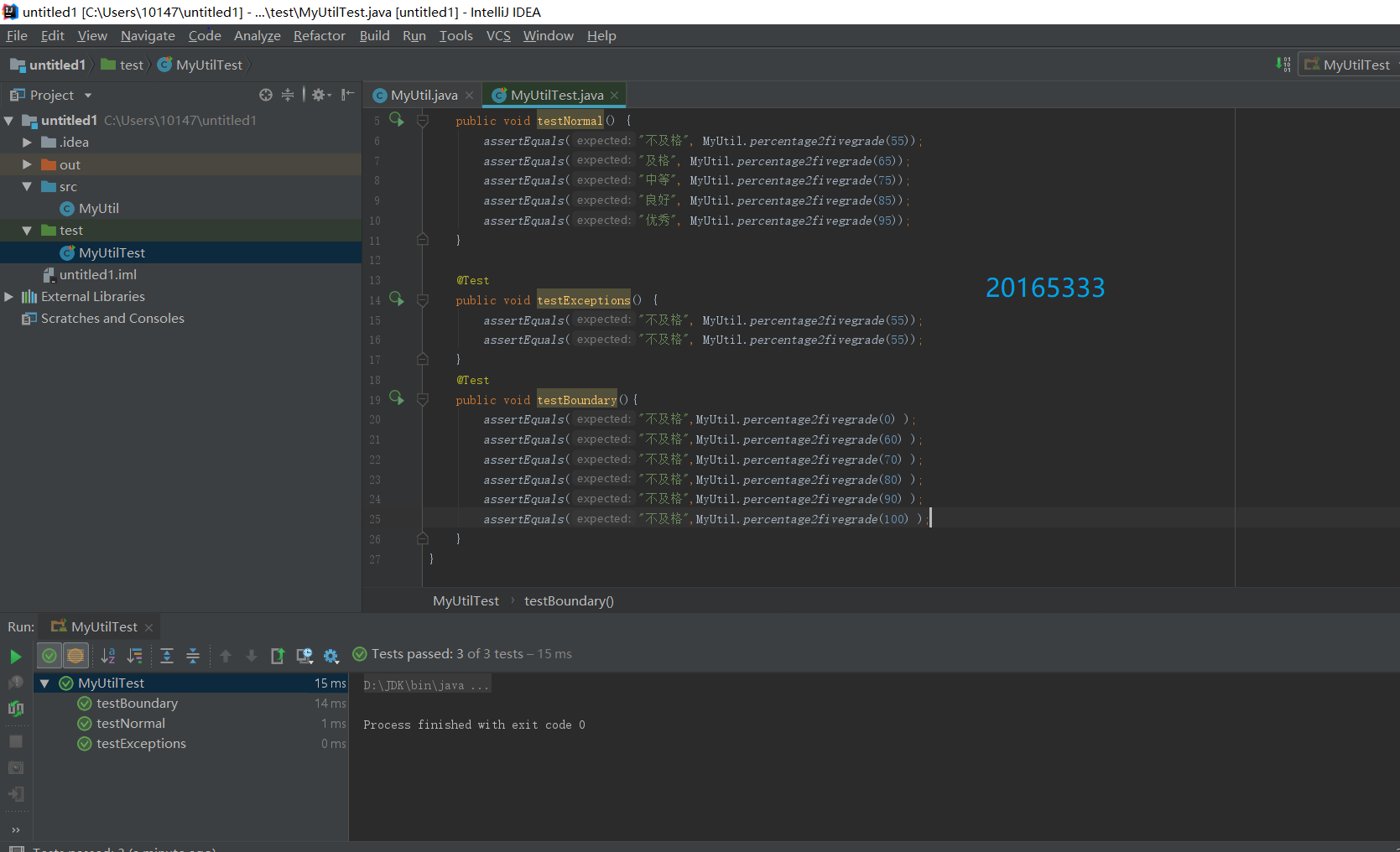
(二)
三要素:封装、继承、多态
-
封装就是将数据与相关行为包装在一起以实现信息就隐藏。
-
继承指一个类的定义可以基于另外一个已经存在的类,即子类基于父类,从而实现父类代码的重用。
-
多态是指不同的类对象调用同一个签名的成员方法时将执行不同代码的现象。
-
产品代码
public class StringBufferDemo{
StringBuffer buffer = new StringBuffer();
public StringBufferDemo(StringBuffer buffer){
this.buffer = buffer;
}
public Character charAt(int i){
return buffer.charAt(i);
}
public int capacity(){
return buffer.capacity();
}
public int length(){
return buffer.length();
}
public int indexOf(String buf) {
return buffer.indexOf(buf);
}
}
- 测试代码
import junit.framework.TestCase;
import org.junit.Test;
import static org.junit.Assert.*;
public class StringBufferDemoTest extends TestCase {
StringBuffer string1 = new StringBuffer("Beautiful");
StringBuffer string2 = new StringBuffer("Beautiful Girls");
StringBuffer string3 = new StringBuffer("Beautiful Girls and Boys");
@Test
public void testCharAt(){
assertEquals('a',string1.charAt(2));
assertEquals(' ',string2.charAt(9));
assertEquals('a',string3.charAt(16));
}
@Test
public void testCapacity(){
assertEquals(25,string1.capacity());
assertEquals(31,string2.capacity());
assertEquals(40,string3.capacity());
}
@Test
public void testindexOf() {
assertEquals(1, string3.indexOf("ea"));
}
@Test
public void testlength() {
assertEquals(9, string1.length());
}
}
结果截图
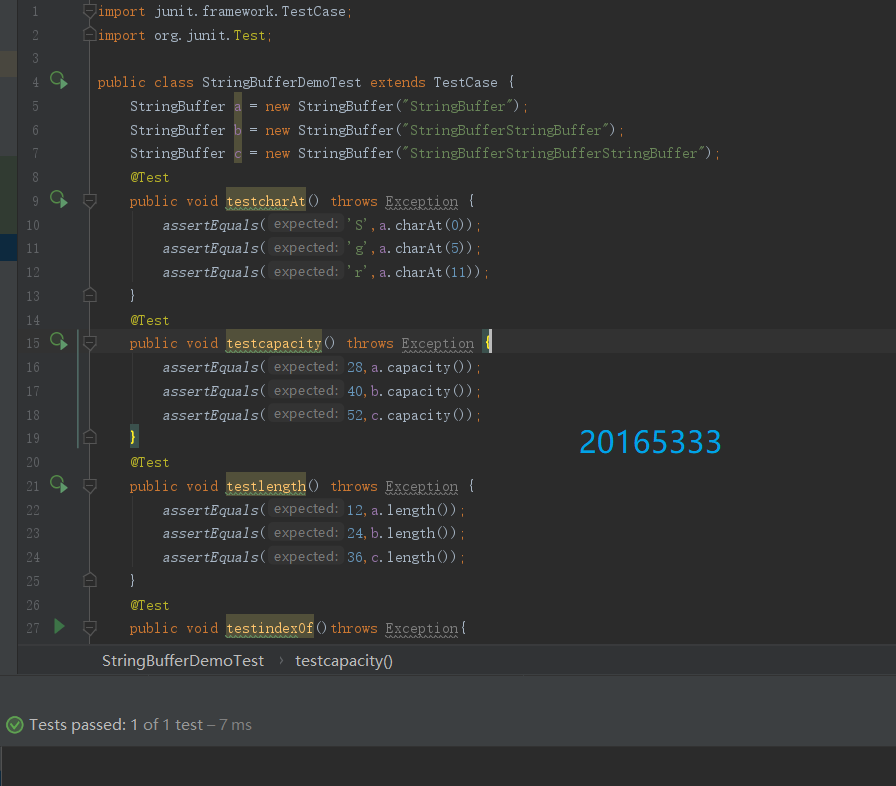
(三)
- SRP(Single Responsibility Principle,单一职责原则)
- OCP(Open-Closed Principle,开放-封闭原则)
- LSP(Liskov Substitusion Principle,Liskov替换原则)
- ISP(Interface Segregation Principle,接口分离原则)
- DIP(Dependency Inversion Principle,依赖倒置原则)
- 老师给出的代码是实现返回int类,题目要求给出返回long类,如果对代码直接进行删改就违反了OCP原则,对增加开放,对删除封闭。所以要使用设计模式了。- 使用面向接口编程,使用抽象和继承。以下是实验任务:
- 用自己的学号(20165333)%6进行取余运算,根据结果进行代码扩充:
0: 让系统支持Byte类,并在MyDoc类中添加测试代码表明添加正确。 - 代码
abstract class Data{
public abstract void DisplayValue();
}
class Integer extends Data {
int value;
Integer(){
value=100; }
public void DisplayValue(){
System.out.println(value);
}
}
class PaseByte extends Data {
Byte value;
PaseByte(){
value=-33;
}
public void DisplayValue(){
System.out.println(value);
}
}
class Document {
Data pd;
Document() {
pd=new PaseByte() ;
}
public void DisplayData(){
pd.DisplayValue();
}
}
public class MyDoc {
static Document d;
public static void main(String[] args) {
d = new Document();
d.DisplayData();
}
}
结果截图
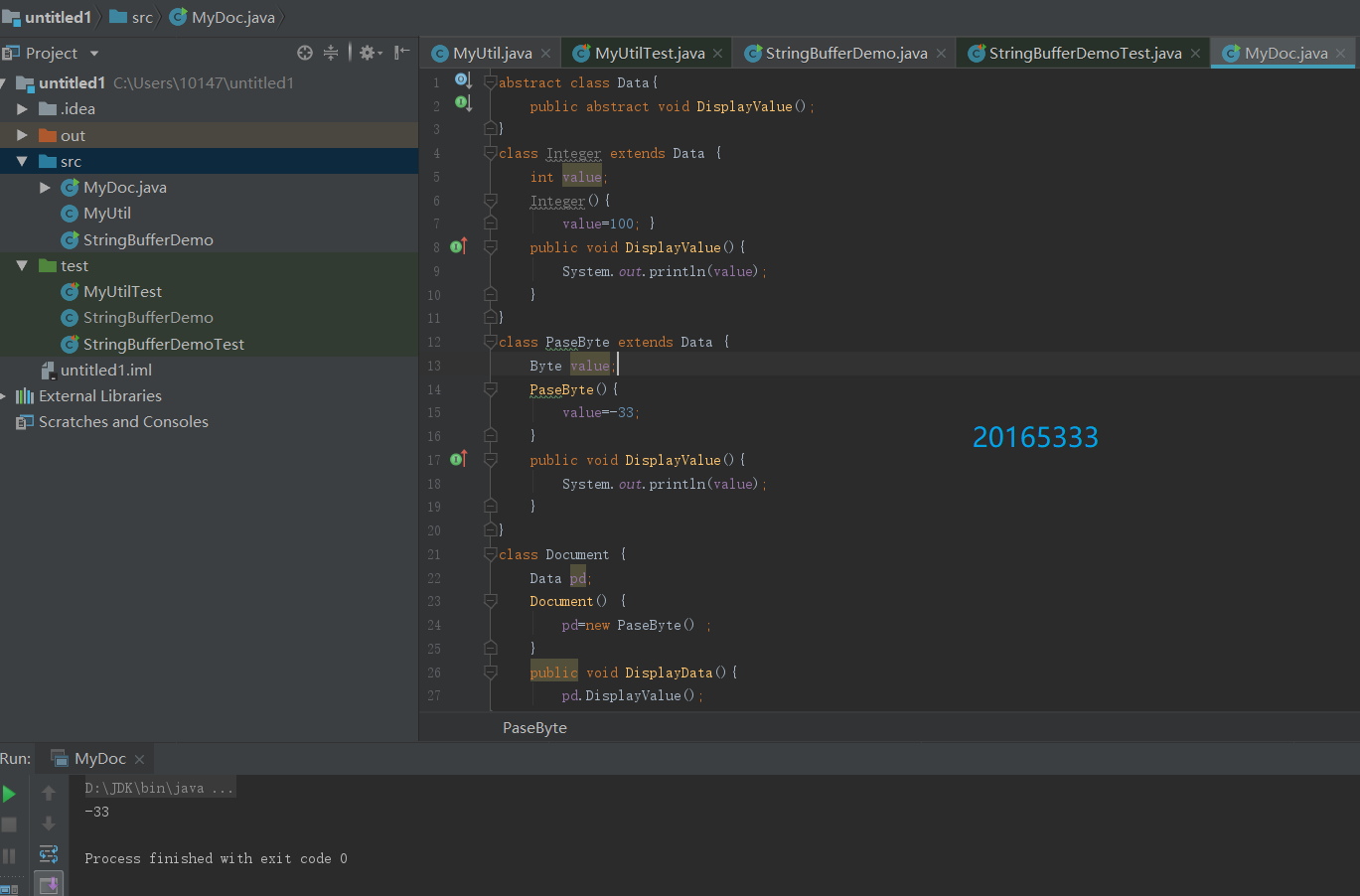
(四)
- 使用TDD的方式设计关实现复数类Complex
// 定义属性并生成getter,setter
double RealPart;
double ImagePart;
// 定义构造函数
public Complex()
public Complex(double R,double I)
//Override Object
public boolean equals(Object obj)
public String toString()
// 定义公有方法:加减乘除
Complex ComplexAdd(Complex a)
Complex ComplexSub(Complex a)
Complex ComplexMulti(Complex a)
Complex ComplexDiv(Complex a) - 产品代码
public class Complex {
// 定义属性并生成getter,setter
double RealPart;
double ImagePart;
// 定义构造函数
public Complex(){
RealPart = 0;
ImagePart = 1;
}
public Complex(double R,double I){
ImagePart = I;
RealPart = R;
}
//Override Object
public boolean equals(Object obj){
if(this == obj) {
return true;
}
if(!(obj instanceof Complex)) {
return false;
}
Complex complex = (Complex) obj;
if(complex.RealPart != ((Complex) obj).RealPart) {
return false;
}
if(complex.ImagePart != ((Complex) obj).ImagePart) {
return false;
}
return true;
}
public String toString() {
String string = "";
if (ImagePart > 0)
string = RealPart + "+" + ImagePart + "i";
if (ImagePart == 0)
string = RealPart + "";
if (ImagePart < 0)
string = RealPart + " " + ImagePart + "i";
return string;
} // 定义公有方法:加减乘除
Complex ComplexAdd(Complex a) {
return new Complex(RealPart+a.RealPart,ImagePart+a.ImagePart);
}
Complex ComplexSub(Complex a) {
return new Complex(RealPart-a.RealPart,ImagePart-a.ImagePart);
}
Complex ComplexMulti(Complex a) {
return new Complex(RealPart*a.RealPart,ImagePart*a.ImagePart);
}
Complex ComplexDiv(Complex a) {
if(a.RealPart==0||a.ImagePart==0) {
System.out.println("被减数不能为0");
return new Complex();
}
double d = Math.sqrt(a.RealPart*a.RealPart)+Math.sqrt(a.ImagePart*a.ImagePart);
return new Complex((RealPart*a.RealPart+ImagePart*a.ImagePart)/d,Math.round((RealPart*a.ImagePart-ImagePart*a.RealPart)/d));
}
}
- 测试代码
import static org.junit.Assert.*;
import org.junit.Test;
import junit.framework.TestCase;
public class ComplexTest extends TestCase {
Complex complex = new Complex(1,1);
@Test
public void testAdd(){
assertEquals(new Complex(3.3,3.4), complex.ComplexAdd(new Complex(2.3,2.4)));
}
//测试加法
@Test
public void testSub(){
assertEquals(new Complex(-5.3,-2.4), complex.ComplexSub(new Complex(6.3,3.4)));
}
//测试减法
@Test
public void testMulti(){
assertEquals(new Complex(3.0,2.0), complex.ComplexMulti(new Complex(3.0,2.0)));
}
//测试乘法
@Test
public void testDiv(){
assertEquals(new Complex(1.0,1.0), complex.ComplexDiv(new Complex(1.0,1.0)));
assertEquals(new Complex(0.0,0.0), complex.ComplexDiv(new Complex(1.0,0.0)));
//assertEquals(new Complex(0.0,0.0), complex.ComplexDiv(new Complex(3,4)));
//边缘测试
}
@Test
public void testequals(){
assertEquals(true, complex.equals(new Complex(1.0,1.0)));
} //测试判断相等
}
结果截图
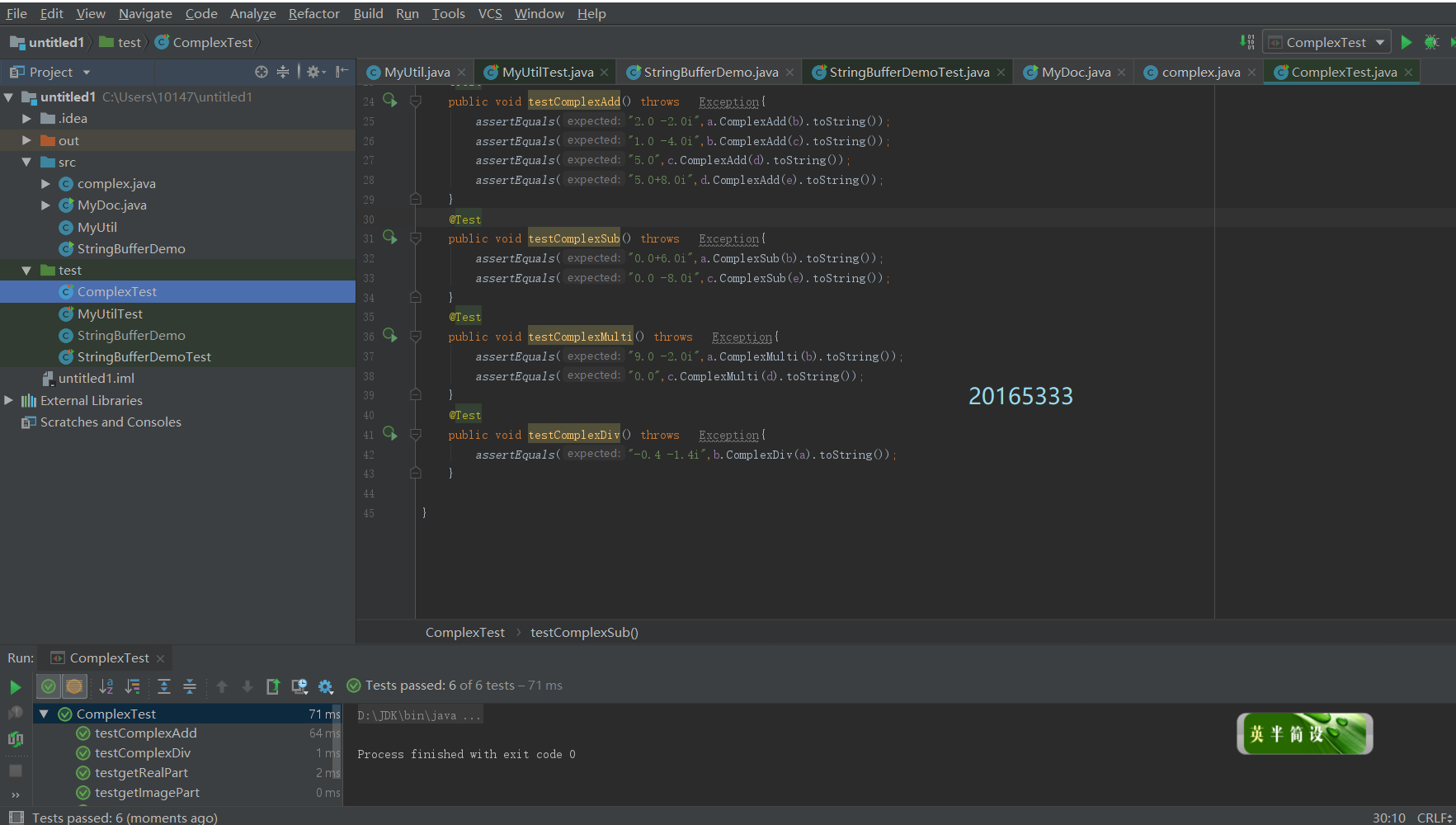
(五)
- 使用WhiteStarUML对实验二中的代码进行建模,发类图的截图,加上学号水印。参考http://www.cnblogs.com/rocedu/p/6736847.html
类图中只少两个类。 - 截图
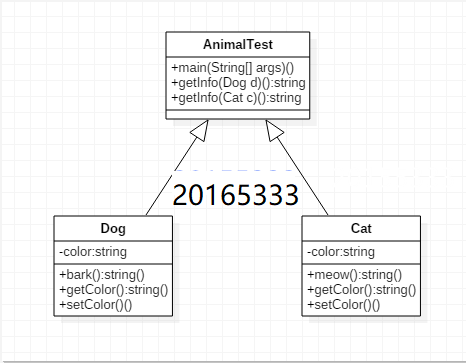
实验过程中遇到的问题
在安装juit的过程中有点小问题,按照教程查找juit.jar文件时,没有找到,最后发现查找的路径错了,以后注意。